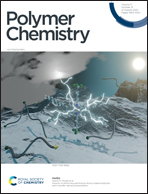Tuning the hydroxyl functionality of block copolymer worm gels modulates their thermoresponsive behavior†
Abstract
Over the past decade or so, polymerization-induced self-assembly (PISA) has become widely recognized as a powerful technology platform for the rational synthesis of sterically-stabilized diblock copolymer nano-objects in concentrated solution. In the present study, a binary mixture of water-soluble poly(glycerol monomethacrylate) (PGMA59) and poly(ethylene glycol) (PEGx, where x = 45 or 113) precursors were simultaneously chain-extended with 2-hydroxypropyl methacrylate (HPMA) using reversible addition–fragmentation chain transfer (RAFT) aqueous dispersion polymerization. For each of the two PEG blocks, a phase diagram was constructed at a fixed copolymer concentration of 10% w/w by systematically varying the target PHPMA DP (n) and the PEG mole fraction (z). The resulting diblock copolymer nano-objects are denoted using the general formula [z PEGx + y PGMA59]-PHPMAn. Using a PEG block DP of 45 (i.e. x = 45), a pure worm phase was identified for just two diblock compositions when z = 0 (namely PGMA59-PHPMA150 and PGMA59-PHPMA160). In striking contrast, using a PEG block DP of 113 enabled twenty examples of pure worms to be obtained for z values ranging between 0.00 and 0.90. The thermoresponsive nature of these worms was assessed by tube inversion experiments and gel rheology studies. Importantly, reversible thermoresponsive behaviour was only observed when z ≤ 0.6 when targeting a PHPMA DP ≤ 180. Moreover, there was no evidence that inter-worm hydrogen bonding between the PGMA59 and PEG113 stabilizer chains leads to stronger gels. These findings are expected to inform future studies focused on evaluating the minimum hydroxyl content of such worm gels that is required to induce stasis in embryonic human stem cells (see I. Canton, et al., ACS Cent. Sci., 2016, 2, 65–74).



 Please wait while we load your content...
Please wait while we load your content...